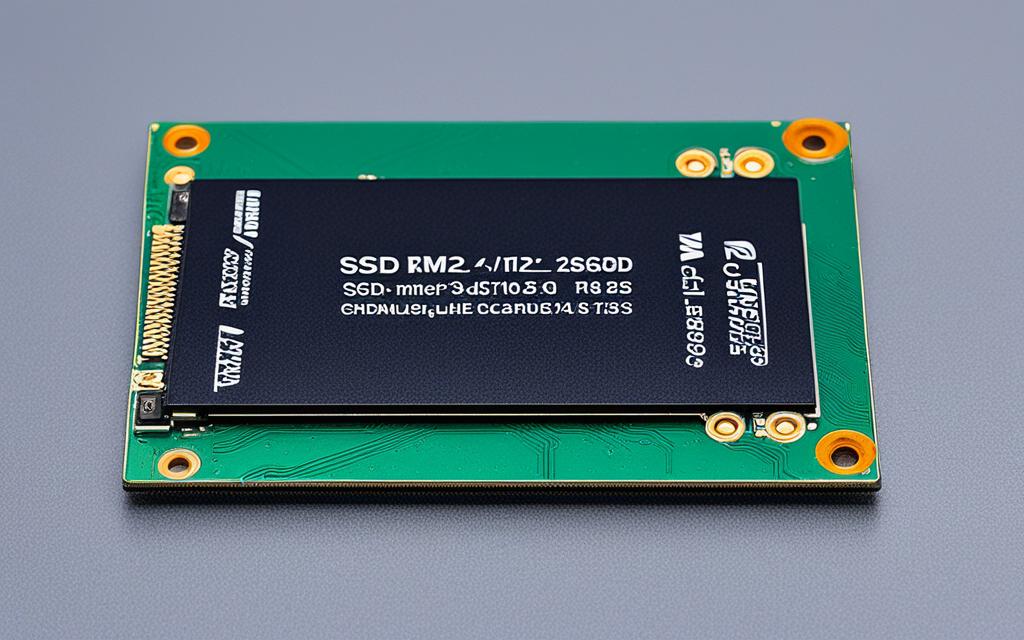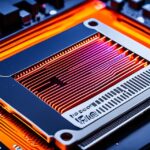Table of Contents
Understanding if you need a heatsink for your M.2 SSD requires knowing how they work. With NVMe technology, these drives offer faster data transfers but get quite hot. Managing their temperature is crucial for top performance and longer drive life. You should think about how you use your SSD and your computer’s setup to decide on cooling. Generally, keeping the SSD’s temperature between 30°C – 65°C is best. Overheating can cause data loss and slow down your SSD, experts explain1.
Key Takeaways
- Understanding the importance of heatsinks for M.2 SSDs is essential for optimal performance.
- High temperatures can adversely impact the functionality of NVMe SSDs, necessitating cooling solutions.
- Temperature management prevents performance throttling and promotes data integrity.
- Choosing the right heatsink can enhance the longevity of your SSD while reducing the risk of overheating.
- Modern motherboards often come with integrated cooling, but their efficacy can vary.
- Specific use cases, such as gaming, may require additional cooling measures for sustaining performance.
Understanding M.2 SSDs
The emergence of M.2 SSDs has transformed storage tech. These drives, designed for the M.2 interface, support SATA and NVMe protocols. The M.2 SSD definition shows their flexibility, allowing for smaller installations and fast performance boosts.
What is an M.2 SSD?
M.2 SSDs stand out for their slim shape and speed. They go beyond what SATA SSDs can do. M.2 vs SATA performance shows M.2 SSDs have faster data rates. This means quicker app and game loading. Gen4 NVMe SSDs offer even higher performance. They’re great for needs like ultra-fast high-speed storage.
These SSDs are improving. They handle large amounts of data well, thanks to advanced tech.
M.2 vs. SATA SSDs
In a storage interface comparison, M.2 SSDs beat SATA SSDs. SATA SSDs look like old 2.5” drives. But, M.2 SSDs use NVMe for faster speeds. This change means more efficient data handling. It’s crucial for modern computers. Gen4 tech makes M.2 SSDs even better compared to SATA.
The Advantages of M.2 NVMe SSDs
M.2 NVMe SSDs are favored by many for their benefits. The M.2 advantages include quick data transfer and being energy-efficient. The benefits of NVMe SSDs also mean better performance for gaming or video editing. Using the M.2 NVMe advantages, users can boost their system’s power. This ensures smooth operation even with heavy tasks.
In wrapping up, knowing about M.2 SSDs is key for modern computing. As high-speed storage demand grows, embracing these technologies helps users stay ahead. Advanced cooling methods, like heatsinks, are important for those with heavy workloads. They keep M.2 drives working well over time234.
How Heat Affects M.2 SSD Performance
Keeping an SSD operating temperature in check is key for the best performance of M.2 SSDs. They are made to work well within a certain temperature range for SSDs. This is usually detailed in the technical guides. For example, a lot of M.2 NVMe SSDs work best from 0°C to 70°C. Staying in this range helps avoid damage from heat, which is crucial for great performance.
Optimal Operating Temperatures
Too much heat can really hurt the working of M.2 SSDs. Studies show about 70% of M.2 SSDs slow down because of too much heat5. It’s very important to control SSD heat well. Lowering the temperature by 10-20 degrees Celsius with a heatsink can make a big difference. Remember, SSDs do best in places with good air flow and the right temperature6.
Performance Throttling Due to Heat
When M.2 SSDs get too hot, they can’t move data as well. This slowing down makes them less responsive and affects how they process data impact of heat on SSDs. If a system doesn’t cool well, M.2 SSDs are three times more likely to fail5. This shows how critical cooling is, especially when you need constant speed and dependability.
Tests show that SSDs in places with not much air get too hot. This tells us that having a good plan for cooling is very important. To keep your M.2 SSD working well for longer, make sure it has a good cooling setup.
Do I Need a Heatsink for My M.2 SSD?
Should you get a heatsink for your M.2 SSD? It depends on a few things. These include the need for heatsinks and the SSD cooling requirements. As we use more storage, how air moves around SSDs gets more important.
Factors that Influence Heatsink Necessity
Several things decide if you need a heatsink for your M.2 SSD. It’s important to think about things like where you use it and what for. Some users find their M.2 SSDs get too hot without heatsinks5.
High-end SSDs often come with heatsinks to make them last longer and work better4. Studies have shown adding a heatsink can greatly lower the temperature. This proves they help keep things cool5.
The Role of System Airflow
It’s key to get the airflow right if you’re thinking about heatsinks for SSDs. Good airflow design keeps SSDs cool by making sure air moves well around them. This is key for keeping temperatures down.
For setups with lots of high-end parts, like GPUs and CPUs, improving airflow can really help with SSD cooling requirements2. When we demand more from our data speeds, good airflow stops SSDs from slowing down due to heat4. Watching how hot SSDs get, especially when they’re working hard, is crucial.
Motherboard Features and M.2 Cooling Solutions
Many modern motherboards now come with better cooling for M.2 SSDs. They have things like SSD coolers, heat spreaders, and special thermal systems. These improve performance a lot. It’s key to know what options you have for the best SSD working, even when things get tough.
Integrated Heat Dissipation Options
SSD cooling is standard in many motherboards, with simple heatsinks and thermal materials. These move heat away from the SSD efficiently. SSDs work best between 0°C and 70°C. So, good cooling is needed to keep up performance when you’re doing heavy tasks72. Better cooling is especially important for new PCIe Gen4 and Gen5 SSDs7. Heatsinks play a big role in this, improving how well and long they work2.
Choosing the Right Cooling Mechanism for Your Setup
When picking SSD cooling, think about your specific needs, like gaming. You can choose between heatsinks that passively cool or active cooling that does a better job. Liquid coolers are also an option. They use liquid to move heat and work better than heatsinks. But, they cost more and need more upkeep2.
Here’s a look at different SSD cooling types, their pros, and cons:
| Cooling Mechanism | Pros | Cons |
|---|---|---|
| Passive Heatsinks | No power required, simple installation | Less effective under extreme loads |
| Active Cooling Solutions | Better temperature control, higher efficiency | Requires additional space and proper power |
| Liquid Cooling | Top heat management, great for powerful setups | Costs more, needs more maintenance |
Knowing your motherboard’s cooling features and picking the right SSD cooler is key. This helps you get the most out of your system while avoiding heat-related issues.
Recent research shows that M.2 SSDs work better with dedicated heatsinks5. This highlights how crucial it is to select the right cooling for reliability and speed.
When Is a Heatsink Essential?
Heatsinks are crucial, especially with Gen4 and Gen5 SSDs. These SSDs often get over 80°C during heavy use21. This can hurt their performance and shorten their life if not controlled. It’s vital to choose the right SSD cooling solutions for these versions. They need specific cooling to stop throttling and keep up steady performance under pressure8.
Choosing Heatsinks for Gen4 and Gen5 SSDs
When picking heatsinks for Gen4 SSDs, think about the material and design. Micro Connectors and Sabrent Rocket are good at cooling1. Overheating can cause big drops in performance and even data loss. So, keeping an eye on temperatures is smart, especially when your SSD works hard2.
Specific Use Cases Requiring Additional Cooling
Heatsinks are needed for intense tasks like gaming, moving lots of data, or big rendering jobs. Without good cooling, you might face slow software or crashes18. Knowing when to use SSD cooling helps your M.2 SSDs last longer and work better, even in tough situations2.
FAQ
What is the primary function of a heatsink for M.2 SSDs?
A heatsink for M.2 SSDs is all about keeping the device cool. It works by getting rid of the heat produced when the SSD is working hard. This helps the SSD run better for longer and stops it from getting too hot.
How do M.2 SSDs differ from traditional SATA SSDs?
M.2 SSDs and SATA SSDs are different in size and speed. While SATA SSDs look like regular 2.5” hard drives, M.2 SSDs are smaller. They also work faster, especially with an NVMe interface.
What temperature range should I monitor for my M.2 SSD?
Your M.2 SSD should stay between 0°C and 70°C. Keeping it within these limits is important. It helps avoid slowing down and keeps it working well.
When is it essential to use a heatsink for M.2 SSDs?
Using a heatsink becomes crucial with high-performance Gen4 and Gen5 M.2 SSDs. These SSDs heat up more during heavy use like gaming or big file transfers. A heatsink helps keep them cool, ensuring they work smoothly.
What factors should I consider when deciding on additional cooling solutions for my M.2 SSD?
Think about your SSD’s workload, your computer’s setup, how well air moves in your case, and your motherboard’s cooling ability. These points will help you choose the right cooling solution.
Do modern motherboards provide sufficient cooling for M.2 SSDs?
Many new motherboards offer cooling options like heatsinks and heatspreaders for M.2 SSDs. Checking these features on your motherboard will show if they meet your cooling needs.
Source Links
- https://www.easeus.com/computer-instruction/do-i-need-a-heatsink-for-my-m2-ssd.html – Do I Need a Heatsink for My M.2 SSD [2024 Full Guide]
- https://www.crucial.com/articles/about-ssd/do-you-need-an-nvme-ssd-heatsink – Do you need an NVMe SSD heatsink?
- https://blog.westerndigital.com/ssd-heatsink-hot-storage-cool-data-m2/ – SSD Heatsink: Hot Data, Cool Storage
- https://www.makeuseof.com/what-is-m2-nvme-ssd-heatsink/ – What Is an M.2 NVMe SSD Heatsink?
- https://rog-forum.asus.com/t5/amd-500-400-series/do-you-use-any-additional-cooling-for-m-2-ssd/td-p/774204 – Do you use any additional cooling for M.2 SSD?
- https://www.atpinc.com/about/stories/overcoming-nvme-thermal-throttling-temperature – NVMe SSD Thermal Management: What We Have Learned from Marathons
- https://www.corsair.com/us/en/explorer/diy-builder/storage/is-cooling-necessary-for-an-m2-nvme-ssd/ – Do you need to cool your M.2 NVMe SSD?
- https://forum.level1techs.com/t/are-nvme-heatsinks-worth-it-990-pro/202418 – Are NVMe Heatsinks Worth It? (990 Pro)








